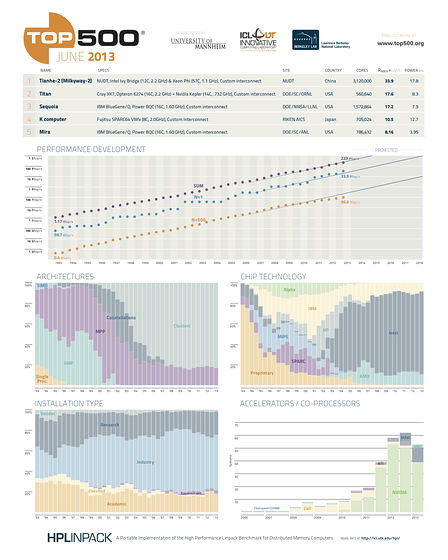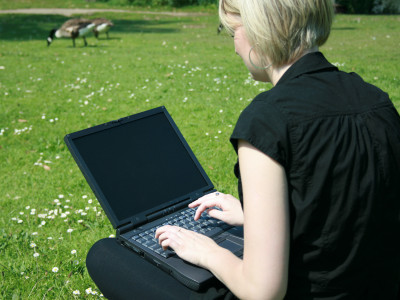The world's fastest super computer top 10 seen in the picture

Supercomputer performance ranking "TOP 500" has been updated once every six months, this time it was updated to "ISC 2013" which is the international conference of supercomputers, and this time it was updated to the last Oak Ridge National Laboratory in America "Tianhe-2" (Tianhe-2) of China National Defense Science and Technology University has broken the "Titan" in No. 1.
China's Tianhe-2 Supercomputer Takes No. 1 Ranking on 41st TOP 500 List | TOP 500 Supercomputer Sites
http://www.top500.org/blog/lists/2013/06/press-release/
That's why, from the tenth place, looking at what the world's top supercomputers look like actually looks like the following.
June 2013 | TOP 500 Supercomputer Sites
http://www.top500.org/lists/2013/06/

◆ 10th place:Tianhe-1A(Tianhe No. 1), the People's Liberation Army National Defense Science and Technology University, Using Intel's Xeon X 5670 (6 cores, 2.93 GHz) and NVIDIA 2050, the number of cores is 18, 63668, the calculation speed is 2.57 petaflops, the power consumption is 4.04 MW

◆ 9th place:SuperMUC, Leibniz Supercomputing Center in Germany, IBM adopted iDataPlex DX 360 M 4, the processor in the use of Infiniband FDR at Intel's Xeon E 5-2680 (8 cores · 2.70 GHz), the number of cores is 144,756, the calculation speed is 2.90 petaflops, the power consumption is 3.42 MW


◆ 8th place:Vulcan, American Lawrence Livermore National Laboratory, IBM BlueGene / Q adopted, Power BQC (16 cores · 1.60 GHz), the number of cores is 390 3216, the calculation speed is 4.3 petaflops, the power consumption is 1.97 MW

◆ 7th place:Juqueen, Jülich Supercomputing Center in Germany, IBM BlueGene / Q, Power BQC (16 cores, 1.60 GHz), the number of cores is 458 8752, the calculation speed is 5.0 petaflops, the power consumption is 2.30 MW

◆ 6th place:Stampede, Texas Advanced Computing Center of the University of Texas, Adopting DELL's PowerEdge C8220, the contents are Xeon E 5-2680 (8 cores, 2.70 GHz), and Infiniband FDR also uses Intel Xeon Phi SE 10 P, the number of cores is 462 242, the calculation speed is 5.2 petaflops, the power consumption is 4.51 MW

◆ 5th place:Mira, The Argonne National Laboratory's energy department in the US, IBM BlueGene / Q, Power BQC (16 cores, 1.60 GHz), the number of cores is 786,432, the calculation speed is 8.6 petaflops, the power consumption is 3.95 MW


◆ 4th place:Supercomputer Kyo, RIKEN Computational Science Research Organization (AICS), Fujitsu SPARC 64 VIIIfx (8 cores · 2.0 GHz), the number of cores is 705,204, the calculation speed is 10.5 petaflops, the power consumption is 12.7 MW


The system board looks something like this

◆ 3rd place:Sequoia, American Lawrence Livermore National Laboratory, IBM BlueGene / Q, Power BQC (16 cores, 1.60 GHz), the number of cores is 1,572,864, the calculation speed is 17.2 petaflops, the power consumption is 7.9 MW



◆ 2nd place:Titan, American Oak Ridge National Laboratory, AMD Opteron 6274 (16 cores · 2.2 GHz) and Nvidia Kepler (14 cores · 0.732 GHz), the number of cores is 56640, the calculation speed is 17.6 petaflops, the power consumption is 8.3 MW



The nVIDIA TESLA you are using is like this

◆ First place:Tianhe-2(Tianhe No 2), the People's Liberation Army National Defense Science and Technology University, Intel's Ivy Bridge (12 cores · 2.2 GHz) and Xeon Phi (57 cores · 1.1 GHz) are adopted, the number of cores is 3120000, the calculation speed is 33.9 petaflops, the power consumption is 17.8 MW

Related Posts:
in Hardware, Posted by darkhorse







